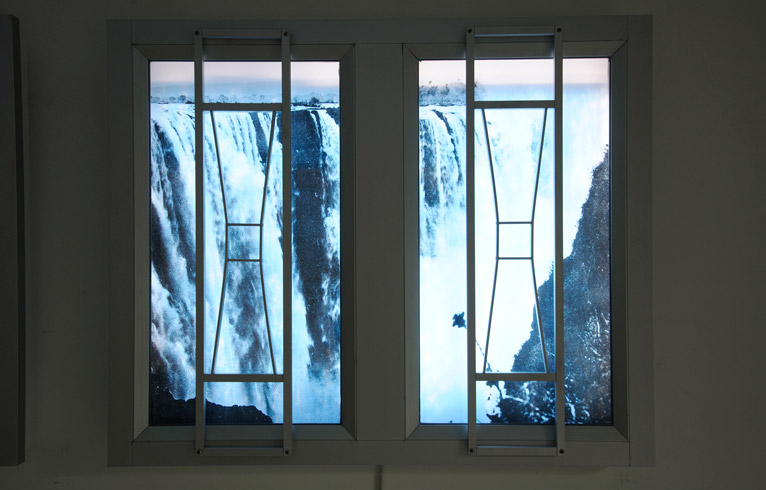NADIM ABBAS: CATARACT
| March 17, 2011 | Post In LEAP 7

Nadim Abbas, in his first complete solo exhibition, brilliantly composes a scene that so resists interpretation that the viewer defaults into passive observation, submitting to a flaccid presentation of spectacle in the absence of any plausible guiding narrative. Several of the artist’s earlier projects fall into the category of conceptual assemblage, consisting of fragments of art-historical imagery, design objects, and other components that collectively produce a surplus of information that ultimately numbs the viewer to the production of specific meaning. Here, however, the problem is reversed: Abbas has fabricated an alternative to the white cube within the white cube, a blinding void of display space that displays nothing at all. Entering through a glass door, hidden away from the neighboring gallery cluster in a rear alley, the audience is held at bay by a steel bar laid horizontally across the space. Directly ahead, a raised platform built over the floor is covered with white tiles, a shallow pool carved out of its center. Beyond this pool a freestanding vertical wall, also of white tile, faces the entryway; near the top, a shower fixture streams luminescent water into the reservoir below. On either side, hanging parallel to this wall, translucent white shower curtains are illuminated from behind, masking a large sound system playing a bass-heavy recording of a waterfall that deepens the tinny sound of the shower installation. On the true wall to the left of the space, two sculptural hanging pieces mimic the slight aluminum window frames common to Hong Kong apartments, their glass panes replaced by the white tiles shared by the shower situation. The exhibition continues in Gallery EXIT nearby with two similar window treatments in which kitschy backlit posters of waterfalls scroll from top to bottom to the accompaniment of another waterfall soundtrack.
Entitled “Cataract,” the project is ambitious and sensually domineering, commanding a certain depth and duration of attention rare to exhibitions so ambiguously imbricated within artistic motivations of the archetypal gallery space. The official narrative of the artist interprets the work as an experiment in optical effect, staging an attack on the crumbling edifice of purely retinal art, and developing the concept of opacity (and, in particular, the moment at which transparent water becomes solid white at a certain speed) as a critique of the place of visual perception within cultures of contemporary art. Although the foundations of this idea are fundamentally literary, originating equally in psychoanalytical and phenomenological readings of textual modernism, the environment itself is profoundly antiseptic, emptying out the raw sentiment required for such an interpretation. Indeed, due to the barreling sound and sight of the shower-aswaterfall, the viewer is instead required to submit, to remain external to and intensely critical of this vision from which she cannot pull away. There is a distinct refusal of immersion, of which the bar across the entrance is only the most literal manifestation. This entire architecture, warped as it is to create a singular physical effect and designed to provoke the cultural interpellation of sensory input, never progresses beyond the vacuum of concrete meaning it creates. It would be simple, too, to approach anew Abbas’s prior production through the lens of this disastrously attractive monument to blankness. Yet perhaps what the artist wishes to pursue is, after all, precisely this clarity in opacity, a defining situation into which he might funnel the energies of artistic practice today—an environment that turns upon its audience by positioning the viewer as the only truly legible actor within the system at stake. Far from producing meaning in the mechanical architecture as Abbas might have anticipated, the glaring white void swallows any possibility of interpretation, enacting the code of the inexplicable so fetishized in post-conceptual strategies while laying bare its hollow attractions. Robin Peckham

